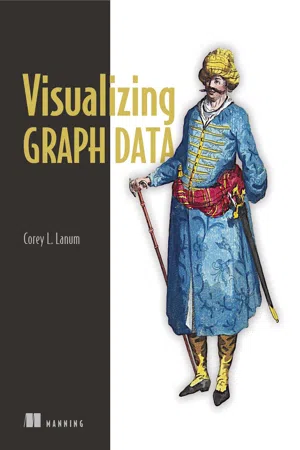
- 232 pages
- English
- ePUB (mobile friendly)
- Available on iOS & Android
Visualizing Graph Data
About this book
Summary Visualizing Graph Data teaches you not only how to build graph data structures, but also how to create your own dynamic and interactive visualizations using a variety of tools. This book is loaded with fascinating examples and case studies to show you the real-world value of graph visualizations. Purchase of the print book includes a free eBook in PDF, Kindle, and ePub formats from Manning Publications. About the Technology Assume you are doing a great job collecting data about your customers and products. Are you able to turn your rich data into important insight? Complex relationships in large data sets can be difficult to recognize. Visualizing these connections as graphs makes it possible to see the patterns, so you can find meaning in an otherwise over-whelming sea of facts. About the Book Visualizing Graph Data teaches you how to understand graph data, build graph data structures, and create meaningful visualizations. This engaging book gently introduces graph data visualization through fascinating examples and compelling case studies. You'll discover simple, but effective, techniques to model your data, handle big data, and depict temporal and spatial data. By the end, you'll have a conceptual foundation as well as the practical skills to explore your own data with confidence. What's Inside
- Techniques for creating effective visualizations
- Examples using the Gephi and KeyLines visualization packages
- Real-world case studies
About the Reader No prior experience with graph data is required. About the Author Corey Lanum has decades of experience building visualization and analysis applications for companies and government agencies around the globe. Table of Contents
PART 1 - GRAPH VISUALIZATION BASICS
- Getting to know graph visualization
- Case studies
- An introduction to Gephi and KeyLines
PART 2 VISUALIZE YOUR OWN DATA
- Data modeling
- How to build graph visualizations
- Creating interactive visualizations
- How to organize a chart
- Big data: using graphs when there's too much data
- Dynamic graphs: how to show data over time
- Graphs on maps: the where of graph visualization
Frequently asked questions
- Essential is ideal for learners and professionals who enjoy exploring a wide range of subjects. Access the Essential Library with 800,000+ trusted titles and best-sellers across business, personal growth, and the humanities. Includes unlimited reading time and Standard Read Aloud voice.
- Complete: Perfect for advanced learners and researchers needing full, unrestricted access. Unlock 1.4M+ books across hundreds of subjects, including academic and specialized titles. The Complete Plan also includes advanced features like Premium Read Aloud and Research Assistant.
Please note we cannot support devices running on iOS 13 and Android 7 or earlier. Learn more about using the app.
Information
Part 1. Graph visualization basics
Chapter 1. Getting to know graph visualization
- Getting to know graphs as data models
- Why graphs are a useful way to think about data
- When to visualize graphs, and the node-link drawing concept
- Other visualizations of graph data and when they’re useful
1.1. Getting to know graphs
1.1.1. What is a graph?
- Directed— The relationship has a direction. Stella owns the car, but it doesn’t make sense to say the car owns Stella.
- Undirected— The two items are linked without the concept of direction; the relationship inherently goes both ways. If Stella is linked to Roger because they committed a crime together, it means the same thing to say Stella was arrested with Roger as it does to say Roger was arrested with Stella.
Figure 1.1. A property graph of a single email between Enron executives. The two nodes are the sender and recipient of the email, and the directed edge is the email.

Figure 1.2. A simple property graph with two nodes and an edge. Stella (the first node) bought a 2008 Volkswagen Jetta (the second node) in September 2007 and sold it in October 2013. Modeling it as a graph highlights that Stella had a relationship with this car (the edge).

Figure 1.3. A graph of some of the Enron executives’ email communications. You can easily see that Timothy Belden is a hub of communication in this segment of Enron, sending and receiving email from many other executives.

1.1.2. A bit of theory
Figure 1.4. The Seven Bridges of Königsberg problem. Using this map of the bridges of Königsberg, Prussia, try to draw a route that reaches each area of the city but never crosses the same bridge twice.

Figure 1.5. Seven bridges and four land areas of Königsberg as a graph. In this graph, nodes denote the land masses bordering the Pregel River and the two islands in its middle. Edges represent the bridges connecting the two islands and two shorelines.

Table of contents
- Copyright
- Brief Table of Contents
- Table of Contents
- Preface
- Acknowledgments
- About this Book
- About the Author
- About the Cover Illustration
- Part 1. Graph visualization basics
- Part 2. Visualize your own data
- Appendix. A tutorial on D3.js
- Index
- List of Figures
- List of Tables
- List of Listings